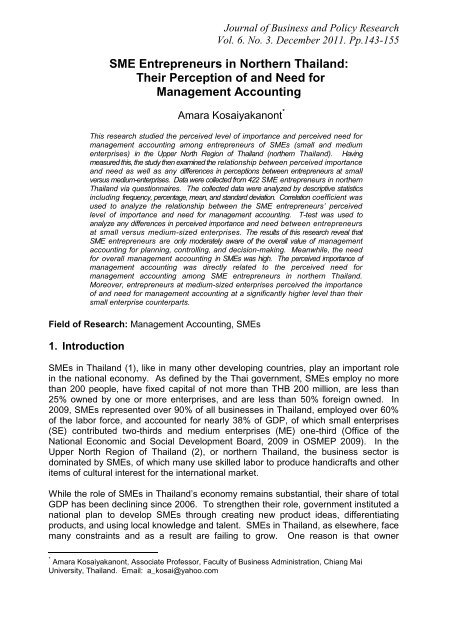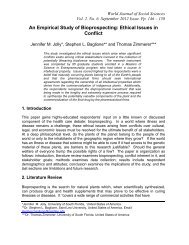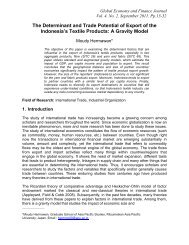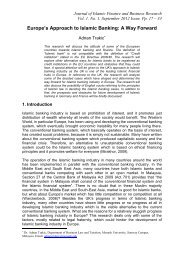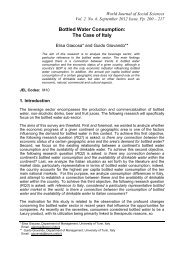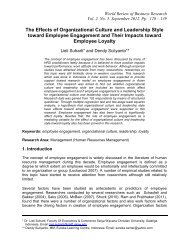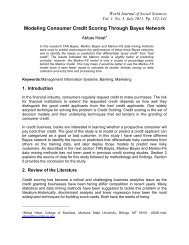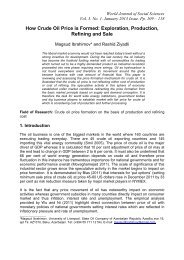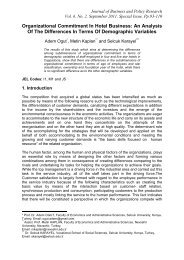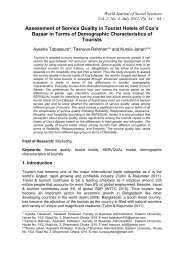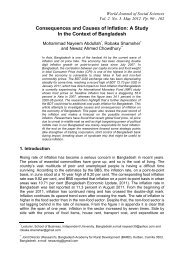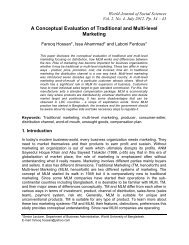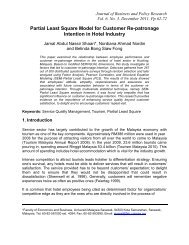SME Entrepreneurs in Northern Thailand: Their ... - Wbiaus.org
SME Entrepreneurs in Northern Thailand: Their ... - Wbiaus.org
SME Entrepreneurs in Northern Thailand: Their ... - Wbiaus.org
You also want an ePaper? Increase the reach of your titles
YUMPU automatically turns print PDFs into web optimized ePapers that Google loves.
Kosaiyakanontcontroll<strong>in</strong>g, especially for cost production and cash receipt and disbursement. Smallenterprises had moderate levels of perceived importance, focus<strong>in</strong>g first on cashfollowed by cost production.Table 3: <strong>SME</strong> <strong>Entrepreneurs</strong>’ Perceived Importanceof Management Account<strong>in</strong>g for Decision-mak<strong>in</strong>gImportance for Medium Enterprise Small Enterprise <strong>SME</strong>sDecision-mak<strong>in</strong>gonxˉ S.D level xˉ S.D level xˉ S.D levelPric<strong>in</strong>g 3.71 .995 H 3.58 .911 H 3.59 0.920 HVolume to beproduced3.69 .869 H 3.49 .926 M 3.51 0.921 HOrder accept<strong>in</strong>g 3.74 .885 H 3.36 1.055 M 3.40 1.044 MMake or buyproduct3.50 .862 H 3.29 1.070 M 3.31 1.052 MDrop product 3.26 1.037 M 3.00 1.138 M 3.03 1.130 MInvestment/expansion3.57 1.039 H 3.24 1.196 M 3.28 1.184 MTotal 3.57 .947 H 3.32 1.049 M 3.35 1.042 MNote: H = high, M = moderate.The results <strong>in</strong> Table 3 show that the level of perceived importance of managementaccount<strong>in</strong>g <strong>in</strong> decision-mak<strong>in</strong>g for medium enterprises was high and focused foremoston order accept<strong>in</strong>g, while the perception level for small enterprises was moderate andfocused most on price sett<strong>in</strong>g .Table 4: <strong>SME</strong> <strong>Entrepreneurs</strong>’ Perceived Needfor Management Account<strong>in</strong>g for Plann<strong>in</strong>gNeed for Medium Enterprise Small Enterprise <strong>SME</strong>sPlann<strong>in</strong>g of xˉ S.D level xˉ S.D level xˉ S.D levelSales 3.81 .804 H 3.96 .859 H 3.95 0.854 HProduction 3.79 .898 H 3.59 .895 H 3.61 0.896 HCash receiptedand3.98 .869 H 3.89 .896 H 3.90 0.893 HdisbursementInvestment /expansion3.90 .878 H 3.52 1.064 H 3.56 1.052 HProfit 4.12 .803 H 3.92 .935 H 3.94 0.924 HIncome taxes 3.93 .867 H 3.44 1.060 M 3.49 1.051 MTotal 3.92 .853 H 3.72 .951 H 3.74 0.945 HNote: H = high, M = moderate.The results <strong>in</strong> Tables 4, 5 and 6 show that both small and medium enterprises hadhigh levels of needs for management account<strong>in</strong>g <strong>in</strong> every aspect. <strong>Entrepreneurs</strong> <strong>in</strong>medium enterprises ranked the need for management account<strong>in</strong>g <strong>in</strong> profit plann<strong>in</strong>g forplann<strong>in</strong>g, cost production for controll<strong>in</strong>g, and price sett<strong>in</strong>g for decision-mak<strong>in</strong>g thehighest. In turn, entrepreneurs <strong>in</strong> small enterprises ranked sales volume for plann<strong>in</strong>g,cash for controll<strong>in</strong>g, and price sett<strong>in</strong>g for decision-mak<strong>in</strong>g the highest.149
KosaiyakanontTable 5: <strong>SME</strong> <strong>Entrepreneurs</strong>’ Perceived Needfor Management Account<strong>in</strong>g for Controll<strong>in</strong>gNeed for Medium Enterprise Small Enterprise <strong>SME</strong>sControll<strong>in</strong>g of xˉ S.D level xˉ S.D level xˉ S.D levelSales 3.79 .842 H 3.77 .919 H 3.77 0.911 HCost ofproduction4.17 .696 H 3.84 .861 H 3.87 0.851 HCash receiptedand4.05 .731 H 3.90 .929 H 3.92 0.912 HdisbursementSell<strong>in</strong>g andadm<strong>in</strong>istrative 4.07 .677 H 3.77 .964 H 3.80 0.943 HexpenseTotal 4.02 .736 H 3.82 .918 H 3.84 0.904 HNote: H = high, M = moderate.Table 6: <strong>SME</strong> <strong>Entrepreneurs</strong>’ Perceived Needfor Management Account<strong>in</strong>g for Decision-mak<strong>in</strong>gNeed for Medium Enterprise Small Enterprise <strong>SME</strong>sDecisionmak<strong>in</strong>gonxˉ S.D level xˉ S.D level xˉ S.D levelPric<strong>in</strong>g 3.90 .850 H 3.82 .891 H 3.83 0.887 HProductionvolume above 3.90 .821 H 3.73 1.002 H 3.75 0.986 HbreakevenAccept order<strong>in</strong>g 3.90 .821 H 3.63 .986 H 3.66 0.973 HMake or buy 3.71 .864 H 3.51 .984 H 3.53 0.974 HDrop production 3.57 .770 H 3.17 1.094 M 3.21 1.072 MInvestment /expansion3.88 .803 H 3.51 1.096 H 3.55 1.075 HTotal 3.81 .821 H 3.56 1.008 H 3.59 0.995 HNote: H = high, M = moderate.<strong>Entrepreneurs</strong> at both small and medium enterprises showed a high perceived needfor management account<strong>in</strong>g with cash receipts and disbursement for plann<strong>in</strong>g, andhad quite high need levels for control. This supported the study of Collis & Jarvis(2002), who po<strong>in</strong>ted out that small private companies placed strong emphasis oncontroll<strong>in</strong>g cash.<strong>SME</strong>s entrepreneurs had high level needs of management account<strong>in</strong>g for plann<strong>in</strong>g,controll<strong>in</strong>g and decision-mak<strong>in</strong>g especially <strong>in</strong> profit plann<strong>in</strong>g, cash, cost of production,and sell<strong>in</strong>g and adm<strong>in</strong>istrative expenses. This supported prior research, which statedthat <strong>SME</strong>s had <strong>in</strong>dependent ownership that kept close control as the pr<strong>in</strong>cipal decisionmaker tak<strong>in</strong>g part <strong>in</strong> every bus<strong>in</strong>ess action (Hill 2001; Chuang et al. 2007; Reijonen &Komppula 2007; Omerzel & Antoncic 2008; Nandan 2010).Hypothesis H 1 regard<strong>in</strong>g the correlation between <strong>SME</strong>s entrepreneurs‟ perception ofand need for management account<strong>in</strong>g was tested us<strong>in</strong>g a correlation coefficient. Theresults show that <strong>SME</strong> perceptions had positive correlation with their needs <strong>in</strong> everyaspect (Table 7).The positive correlation between the entrepreneurs‟ perceived importance of and needfor management account<strong>in</strong>g will stimulate a sense of enthusiasm for adopt<strong>in</strong>g150
Kosaiyakanontmanagement account<strong>in</strong>g to their needs (Hockey 1970; Pech & Cameron 2006). Also,if they perceive a need for it, they will open their m<strong>in</strong>ds to learn<strong>in</strong>g and <strong>in</strong>creas<strong>in</strong>gknowledge.Table 7: Correlation between Perception of and Need forManagement Account<strong>in</strong>gCoefficientCorrelation betweenMediumPerception and Need Small Enterprise<strong>SME</strong>sEnterprisePlann<strong>in</strong>g .624** .379* .608**Controll<strong>in</strong>g .604** .500** .601**Decision-mak<strong>in</strong>g .642** .507** .634**Total .690** .513** .682**Note: * significant level of 0.05, ** significant level of 0.01.To exam<strong>in</strong>e hypothesis H 2 , whether perception of and need for managementaccount<strong>in</strong>g differs between entrepreneurs of small and medium enterprise, a T-testwas performed. The results, <strong>in</strong> Table 8, show a statistically significant difference ofentrepreneurs‟ perception of management account<strong>in</strong>g <strong>in</strong> plann<strong>in</strong>g, controll<strong>in</strong>g anddecision mak<strong>in</strong>g at significance level of 0.01 or better.Table 8: Perception Differences between <strong>Entrepreneurs</strong>of Small and Medium EnterprisesEnterprise N xˉ S.D t SigPlann<strong>in</strong>gSmallMediumControll<strong>in</strong>gSmallMediumDecision Mak<strong>in</strong>gSmallMediumOverallSmallMedium3804238042380423804237.2441.7124.1926.8619.9621.4881.2290.059.107.655.614.385.184.7819.1714.98-3.06 .002-3.63 .001-1.81 .071-3.51 .001Table 9: Need Differences between <strong>Entrepreneurs</strong>of Small and Medium EnterprisesEnterprise N xˉ S.D t SigPlann<strong>in</strong>gSmallMediumControll<strong>in</strong>gSmallMediumDecision Mak<strong>in</strong>gSmallMediumOverallSmallMedium3804238042380423804222.3323.5215.2716.0721.3822.8858.9862.484.534.173.192.424.943.8111.779.19-1.63 .102-1.95 .055-2.35 .022-2.27 .027151
KosaiyakanontThere is only need for management account<strong>in</strong>g <strong>in</strong> decision mak<strong>in</strong>g which smallenterprise was different from medium enterprise at significant level of 0.05 mean whilemedium enterprise needs for management account<strong>in</strong>g <strong>in</strong> plann<strong>in</strong>g and controll<strong>in</strong>g werenot different between small and medium enterprise (Table9). Overall, small enterpriseperceptions of and needs for management account<strong>in</strong>g were different from those ofmedium enterprises.Medium enterprise entrepreneurs perceived the potential value and importance ofmanagement account<strong>in</strong>g more than their small enterprise counterparts. Mediumenterprise entrepreneurs‟ higher perceived importance might derive from their highereducational background, on average. This is supported by Hambrick & Mason (1984)and Omerzel & Antoncic (2008) who found that highly educated entrepreneurs orowner/managers seem to be more receptive to new ideas.In summary, for the first hypothesis (H 1 ), from the positive correlation found between<strong>SME</strong>s entrepreneurs‟ perceptions and needs, it can be conjectured that the more theentrepreneur perceives the importance and useful of management account<strong>in</strong>g, themore they need it. Investigat<strong>in</strong>g the levels of perceptions and needs for the <strong>in</strong>dividualcomponents of management account<strong>in</strong>g (Table 1-6) supports the hypothesis as well.For example, for plann<strong>in</strong>g, SE and ME perceived the importance of cash the highestand perceived need for cash second highest. For controll<strong>in</strong>g, the highest SEentrepreneurs‟ perception of and needs for was cash and for ME entrepreneurs wasproduction cost. For decision mak<strong>in</strong>g, the highest SE entrepreneurs‟ perception waspric<strong>in</strong>g whilst for ME entrepreneurs it was order accept<strong>in</strong>g followed by pric<strong>in</strong>g. So forboth, pric<strong>in</strong>g was one of the highest needs. This <strong>in</strong>dicated that entrepreneurs‟perceptions of management account<strong>in</strong>g (based on their skills, knowledge andeducation) were directly related to their needs. It is consistent with Pech andCameron‟s (2006) suggestion that if the entrepreneurs‟ sense of <strong>in</strong>tuition (based onskills, knowledge, and will<strong>in</strong>gness to take risks) sends positive signals concern<strong>in</strong>g the<strong>in</strong>formation, the opportunity is then enacted through a high need for challenge andexcitatory stimulation. F<strong>in</strong>ally, the f<strong>in</strong>d<strong>in</strong>g of the correlation between entrepreneurs‟perceptions of and needs for management account<strong>in</strong>g is of abundant benefit to <strong>SME</strong>sentrepreneurs <strong>in</strong> terms of enhanc<strong>in</strong>g their perceived knowledge <strong>in</strong> managementaccount<strong>in</strong>g through their needs (by tra<strong>in</strong><strong>in</strong>g or educat<strong>in</strong>g). For <strong>SME</strong>s entrepreneurs <strong>in</strong>northern <strong>Thailand</strong>, accord<strong>in</strong>g to this study, they should strengthen their managementaccount<strong>in</strong>g knowledge based on their needs (Table 4-6), which was sales volume,profit and cash <strong>in</strong> the plann<strong>in</strong>g function; cash, cost of production and sell<strong>in</strong>g andadm<strong>in</strong>istrative expense <strong>in</strong> the controll<strong>in</strong>g function; and pric<strong>in</strong>g, break-even po<strong>in</strong>tvolume and order accept<strong>in</strong>g <strong>in</strong> the decision-mak<strong>in</strong>g function. The level of <strong>SME</strong>sperceptions (Table 1-3) implies that they lacked management account<strong>in</strong>g knowledge <strong>in</strong>plann<strong>in</strong>g <strong>in</strong> the areas of <strong>in</strong>come taxes, <strong>in</strong>vestment for expansion and short-term loansolvency; <strong>in</strong>vestment expansion and sales for the controll<strong>in</strong>g function; anddiscont<strong>in</strong>u<strong>in</strong>g or dropp<strong>in</strong>g production, <strong>in</strong>vestment expansion and make or buy th<strong>in</strong>gs <strong>in</strong>the decision-mak<strong>in</strong>g function.In terms of educat<strong>in</strong>g or tra<strong>in</strong><strong>in</strong>g for <strong>SME</strong>s entrepreneurs, the program design shouldfulfill their needs and their lack of knowledge. From the outcome of the differencebetween SE entrepreneurs and ME entrepreneurs <strong>in</strong> perceptions of and needs formanagement account<strong>in</strong>g (Table 8-9), tra<strong>in</strong><strong>in</strong>g should be <strong>org</strong>anized, with moreemphasis and frequency for SE entrepreneurs than ME entrepreneurs, especially forplann<strong>in</strong>g and control.152
KosaiyakanontThis study was limited to <strong>SME</strong>s <strong>in</strong> the production sector <strong>in</strong> northern <strong>Thailand</strong> andfocused only on the level of their perceptions of and needs for managementaccount<strong>in</strong>g, rather than their specific knowledge or specific techniques <strong>in</strong> managementaccount<strong>in</strong>g. Therefore, further study should <strong>in</strong>vestigate the specific knowledge andtechniques of management account<strong>in</strong>g <strong>in</strong> which <strong>SME</strong>s are lack<strong>in</strong>g. The new f<strong>in</strong>d<strong>in</strong>gresult of the l<strong>in</strong>k between <strong>SME</strong>s entrepreneurs‟ perception of and need formanagement account<strong>in</strong>g contributes to <strong>SME</strong>s entrepreneurs‟ competenciesenhancement.5. ConclusionThe study <strong>in</strong>dicated that entrepreneurs‟ overall perceived importance of managementaccount<strong>in</strong>g‟s usefulness for <strong>SME</strong>s was moderate, though when broken out byenterprise size, was high <strong>in</strong> medium enterprises and moderate <strong>in</strong> small enterprises.<strong>Entrepreneurs</strong> at both small and medium enterprises expressed a high perceived needfor management account<strong>in</strong>g <strong>in</strong> their bus<strong>in</strong>esses. The significant difference <strong>in</strong>perceived importance and needs between small enterprise and medium enterprisesprobably reflects differences <strong>in</strong> educational background and knowledge. Thecorrelation between perceived importance and perceived needs was positive. Thismight stimulate entrepreneurs‟ enthusiasm for learn<strong>in</strong>g about and adopt<strong>in</strong>gmanagement account<strong>in</strong>g for use <strong>in</strong> their <strong>SME</strong>s. Know<strong>in</strong>g the level of their needs andperceptions will be useful <strong>in</strong> design<strong>in</strong>g appropriate tra<strong>in</strong><strong>in</strong>g programs for them. Afuture study that identified the specific knowledge and techniques of managementaccount<strong>in</strong>g lack<strong>in</strong>g <strong>in</strong> <strong>SME</strong>s would further benefit entrepreneurs‟ competencies andperformance.Endnotes1. <strong>SME</strong>s <strong>in</strong> <strong>Thailand</strong> are classified as:SmallMedium# employees capital (THBm) #employees capital (THBm)Production
KosaiyakanontDane, E & Pratt, MG 2007, ‟Explor<strong>in</strong>g <strong>in</strong>tuition and its role <strong>in</strong> managerial decision mak<strong>in</strong>g‟,Academy of Mangement Review, vol. 32, no. 1, pp. 33-54.Jung, CG 1933, Psychological types, Harcourt, Brace and Company, New York.Dirsmith, MW 1998, Account<strong>in</strong>g and control as a solution to technical problems, politicalexchanges and forms of social discourse: The importance of substantivedoma<strong>in</strong>, Behavioral Research <strong>in</strong> Account<strong>in</strong>g, vol. 10 supplement, pp. 65-77.Gaidienė, Z & Skyrius, R 2006, „The usefulness of management account<strong>in</strong>g <strong>in</strong>formation:users‟ attitudes‟, Ekonomika, ISSN1392-1258, pp. 21-37.Hambrick, DC & Mason, PA 1984, „Upper echelons: the <strong>org</strong>anization as a reflection ofits top managers‟, Academy of Management Review, vol. 9, no. 2, pp. 193-206.Hill,J 2001, „A multidimensional study of the key determ<strong>in</strong>ants of effective <strong>SME</strong> market<strong>in</strong>gactivity: part 1‟, International Journal of Entrepreneurial Behavior & Research,vol.7,no.5,pp.171-204.Hilton, R H & Platt, DE 2011, Managerial Account<strong>in</strong>g, global edition, McGraw-Hill/Irv<strong>in</strong>, NewYork.Hockey, GR 1970, „Signal probability and spatial location as possible bases for <strong>in</strong>creasedselectivity <strong>in</strong> noise‟, Quarterly Journal of Experimental Psychology, vol. 22,issue 1, pp. 37-42.Kirby, D & K<strong>in</strong>g, S 1997, „Accountant and small firm development: fill<strong>in</strong>g the expectation gap‟,The Service Industries Journal, vol. 17, no. 2, pp. 294-304.Mitchell, F & Reid,G 2000, „Problems, challenges and opportunities: small bus<strong>in</strong>ess as a sett<strong>in</strong>gfor management account<strong>in</strong>g research‟, Management Account<strong>in</strong>g Research, vol. 11, no.4, pp. 385-390.Nandan, R 2010, „Management account<strong>in</strong>g needs of <strong>SME</strong>s and the role of professionalaccountants: A renewed research agenda‟, Journal of Applied Management Account<strong>in</strong>gResearch, vol. 8, no.1, pp. 65-78.Office of Small and Medium Enterprise Promotion (O<strong>SME</strong>P) 2003, „<strong>SME</strong>s def<strong>in</strong>itions’,viewed 2 June 2010, http://pirun.ku.ac.th/~fsciang/km4sme//library/<strong>SME</strong>/Erg/Annex%202.doc.Office of Small and Medium Enterprises Promotion (O<strong>SME</strong>P) 2009, „<strong>Thailand</strong>’swhite paper on small and medium enterprises 2009 and the trends of 2010’, viewed 2June 2010, http://www.sme.go.th/SiteCollection Documents/White%20Paper/2552/Eng_01.pdfOmerzel, D G & Antoncic, B 2008, „Critical entrepreneur knowledge dimensions for the <strong>SME</strong>performance‟, Industrial Management & Data Systems, vol. 108, issue 9, pp. 1182-1199.Pech, RJ & Cameron, A 2006, „An entrepreneurial decision process model describ<strong>in</strong>gopportunity recognition‟, European Journal of Innovation Management, vol. 9, issue1, pp. 61-78.Perren, L & Grant, P2000, „The evolution of management account<strong>in</strong>g rout<strong>in</strong>es <strong>in</strong> smallbus<strong>in</strong>ess: a social construction perspective‟, Management Account<strong>in</strong>g Research,vol. 11, pp. 391 – 411.Pierce, B & O‟Dea, T 2003. „Management account<strong>in</strong>g <strong>in</strong>formation and the needs ofmanagers: Perception of managers and accountants compared‟, The BritishAccount<strong>in</strong>g Review, vol. 35, issue 3,pp. 257-290.Raidl, MH & Lubart, TI 2000-2001, „An empirical study of <strong>in</strong>tuition and creativity‟, Imag<strong>in</strong>ation,Cognition and Personality, 20, pp. 217-230.Reijonen, H & Komppula, R 2007, „Perception of success and its effect on small firmperformance‟, Journal of Small Bus<strong>in</strong>ess and Enterprise Development, vol. 14,issue 4, pp. 689-701.154
KosaiyakanontRuzzier, M & Konecnik, M 2006, „The <strong>in</strong>ternalization strategies of <strong>SME</strong>s: the case ofthe slovenian hotel <strong>in</strong>dustry‟,Management, vol.11,no.1, pp.17-35.Sandburg, J & Targama, A 1998, Ledn<strong>in</strong>g och fÖrståeles-Ett kompetensperepektiv på<strong>org</strong>anisztioner, Studentlitteratur,Lund.Sarapaivanich, N & Kosaiyakanont, A 2007, „Relation between account<strong>in</strong>g Informationknowledge and preparation of account<strong>in</strong>g <strong>in</strong>formation of <strong>SME</strong>s‟ entrepreneur <strong>in</strong>Chiang Mai municipality‟, Proceed<strong>in</strong>g of The 1 st Bus<strong>in</strong>ess ManagementResearch Conference, Chiang Mai University, Chiang Mai,14 March.Scapens, R 2006, „Understand<strong>in</strong>g management account<strong>in</strong>g practices: A personaljourney‟, The British Account<strong>in</strong>g Review, vol. 38, no. 1, pp. 1-30.Sciulli, N 2004, „The use of management account<strong>in</strong>g <strong>in</strong>formation to support contract<strong>in</strong>gout decision mak<strong>in</strong>g <strong>in</strong> the public sector‟, Qualitative Research <strong>in</strong> Account<strong>in</strong>g &Management, vol.1, no. 2, pp. 43-67.Tajnikar, M 2000, „Tvegano poslovodenje: knjiga o gazelah <strong>in</strong> rastocih poslih‟, Visokasola za podjetnistvo, Portoroz.Tanwongsval, V & P<strong>in</strong>vanichkul, T 2007, „Account<strong>in</strong>g <strong>in</strong>formation requirement and report<strong>in</strong>gpractices of Thai <strong>SME</strong>s‟, Journal of Account<strong>in</strong>g Profession, vol. 3, no. 8, pp. 59-74.Westcott, M R & Ranzoni, J H 1963, Correlates of <strong>in</strong>tuitive th<strong>in</strong>k<strong>in</strong>g, Psychological Reportsno.12, pp. 595-613.155


